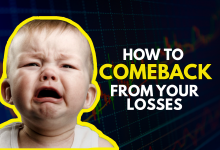Everybody takes a trip to Chinatown at least once in their trading journey. It is painful to see red numbers in your portfolio, signifying a loss, which can oftentimes really take the fun out of trading in the stock market.
If it makes you feel better, even the top traders in the world experience losing a significant amount of money if not all, before getting to where they are right now. Bouncing back from a loss isn’t an easy feat, but with hard work and dedication, it could be easy as ABCDE.
1. ACCEPT
The first step to recover from a loss is to ACCEPT that the loss is your own doing. No one else is to blame for the loss besides you. If you still blame others for the loss that you have incurred, then you are still a long way from recovering the money that you lost. This can be very hard for most people since blaming others is easier than taking responsibility for your own actions, but as they say, the first step is always the hardest.
2. BENCHING
The next step isn’t necessary, but can be very helpful to get you back in shape before you start trading again. BENCHING yourself may suck because we feel the need to immediately get back our lost funds, however this urge is going to be the next reason for yet another loss.
Take a minute to assess what went wrong last time, what you can do about it, and what actions to avoid next time. No one likes to be benched, but even the greatest NBA stars need a break. Think of this as your personal consolidation phase, you’re just charging up before you rocket back up!
3. CREATE
Just because you’re on the bench doesn’t mean you’re out for good. Take this time to CREATE a new plan before you get back in the game. Don’t just create a new plan, but think critically and assess everything that happened in the previous plan in order to create a better one.
This is also the best time to spot entry opportunities in the market where your chances of winning are higher. If you do this step correctly, you wouldn’t just make up for the money that you lost, but you will also add more to your bank!
4. DIGEST
You’ve accepted your mistake, you’ve taken your break, and you’ve created a new plan, the next big step is to DIGEST everything and look things beyond trading. You may be the family man, the breadwinner of your home, or even the superstar of your company’s basketball team.
There is a lot more going on in your life besides your journey in the stock market, and that is why you shouldn’t let this setback affect everything else in your life, especially the ones that you are good at. Digest everything in your life and know that you are worth way more than just a single loss.
5. EXECUTE
Lastly, EXECUTE your comeback. Get back into the ball game stronger and more prepared. Stay motivated and keep your eyes on the big bucks. Keep in mind not to get greedy when green numbers come in. Stick to the game plan and trust everything will fall into place. Remember, ang bida laging talo sa simula. Same goes in trading.
